
Our Tetra Tech Geoenvironmental team describe successful techniques used to remediate asbestos contaminated soil at two city centre sites in Leeds. This article was first published in Environmental Scientist magazine, the journal of the Institute of Environmental Sciences.
The mention of asbestos often strikes fear in the thoughts of many people, including professionals in the construction industry, their clients, and members of the general public. Considering there were approximately 5,500 asbestos related deaths in the UK during 2014, those fears are not without basis. Every fibre inhaled into the lungs increases the potential for asbestos related illnesses to develop, typically many years to decades later. That risk is reflected in Part 2, 11(1) of The Control of Asbestos Regulations (CAR) 2012 which state an employer must:
“Prevent the exposure to asbestos of any employee employed by that employer so far as is reasonably practicable; and where it is not reasonably practicable to prevent such exposure, to take the measures necessary to reduce exposure to asbestos of any such employee to the lowest level reasonably practicable.”
What many people are unaware of is that asbestos fibres are present in the air that we breathe in every day, with concentrations normally higher in urban settings than in rural environments.

The construction and demolition industries have progressively been improving standards. Various bans on the use of asbestos products have culminated in the Asbestos (Prohibitions) Regulations 1999. In contrast, going back to the last century, reports in the geoenvironmental industry, particularly prior to the 1990s, often did not feature asbestos as a possible contaminant.
Even as asbestos started to be included in the analysis of soil as a potential contaminant, there was little industry consensus on what level of risk asbestos in soil posed. For example, what level of asbestos in soil is acceptable in residential garden topsoil and would a regulator agree? Since 2014, that situation has dramatically altered and those changes are currently changing industry practice.
Read the article in full via The Institution of Environmental Sciences website >>.